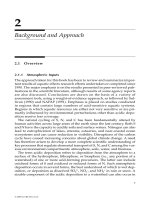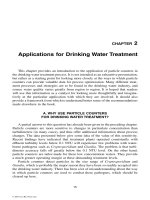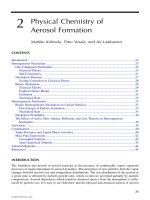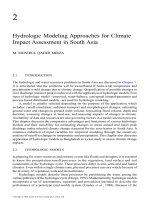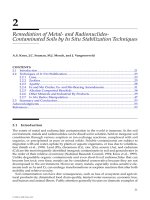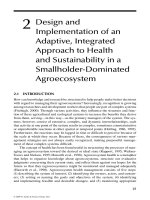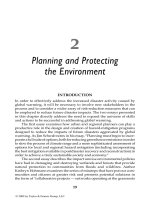INTERFACIAL APPLICATIONS IN ENVIRONMENTAL ENGINEERING - CHAPTER 2 potx
Bạn đang xem bản rút gọn của tài liệu. Xem và tải ngay bản đầy đủ của tài liệu tại đây (216.36 KB, 14 trang )
2
Transient In Situ IR Study of Selective
Catalytic Reduction of NO on
Cu-ZSM-5
XIHAI KANG and STEVEN S. C. CHUANG The University of Akron,
Akron, Ohio, U.S.A.
I. INTRODUCTION
NOx is a precursor to the formation of ground-level ozone and acid rain. Concerns
over the negative impact of NOx on the environment and human health led to
regulation of NOx emission under the provisions of the 1990 Clean Air Act
Amendments (CAAA). The CAAA require a significant decrease in the emission
of NOx, hydrocarbons, and CO over the next few years. The key challenge for
the automobile/truck industries and coal-fired power plants is to develop a cost-
effective catalytic approach for control of NO emission [1–24]. Catalytic ap-
proaches for conversion of NO to N
2
include (1) NO decomposition [25–28], (2)
the NO–CO reaction [29–31], (3) the selective reduction of NO with hydrocar-
bons, and (4) the selective reduction of NO with ammonia [17,32]. The direct
decomposition of NO to N
2
and O
2
is the most attractive approach for NO emis-
sion control. However, no catalysts have been found to exhibit sufficient activities
in the oxidizing environment where a high concentration of O
2
is present in the
exhaust stream. O
2
poisons not only the NO decomposition catalysts but also the
NO–CO reaction catalysts [26–28]. In contrast, the presence of O
2
results in an
increase in NO conversion and N
2
yields in the selective catalytic reduction (SCR)
of NO with hydrocarbons and NH
3
. The interesting role of O
2
in promotion NO
conversion and N
2
formation has led to a large number of postulations [1–24]:
(1) the reaction of O
2
with NO to form highly reactive NO
2
, (2) controlling the
redox cycle of active sites and limiting coke formation, (3) the reaction of O
2
with
hydrocarbons to form oxygenates that further reduce NO, and (4) enhancement of
the rates of both formation and destruction nitrates—the SCR reaction intermedi-
ates.
TM
Copyright n 2003 by Marcel Dekker, Inc. All Rights Reserved.
26 Kang and Chuang
To determine the role of O
2
in the SCR and its raction pathway, we have
employed in situ IR spectroscopy and mass spectrometry to study the dynamic
behaviors of adsorbed species during the step-and-pulse switch of the NO, O
2
,
C
3
H
6
reactant flows during the SCR reaction over Cu-ZSM-5.
II. EXPERIMENTAL
A. Catalyst Preparation
The overexchanged Cu-ZSM-5-523 was prepared by repeated ion exchange of
Cu-ZSM-5-83 with a 0.004 M copper acetate solution of pH ϭ 7. Cu-ZSM-5-
83 was produced by Johnson Matthey and provided through the catalyst bank of
Sandia National Laboratories. The percentage copper exchange is defined as the
molar ratio of the amount of Cu to that of Al multiplied by 2 [% Cu exchange
ϭ 2 (moles of Cu/moles of Al)%] [25]. The ion-exchange Cu-ZSM-5 sample was
filtered, washed by distilled water, dried overnight at 373 K, and then calcined at
733 K for two hours. Inductive coupled plasma emission spectroscopy (Galbraith
Laboratories, Knoxville, TN) determined Si/Al of 24.6 and Cu/Al of 2.6 in Cu-
ZSM-5-523.
B. Reaction System
Figure 1 shows the reaction system, consisting of an in situ infrared (IR) reactor
cell [33], a Nicolet Magna 550 Fourier transform infrared (FTIR) spectrometer,
and a Pfeiffer PRISMA mass spectrometer (MS). A gas distribution system
delivered the reactants and inert gases to the IR reactor cell containing the cata-
lyst. To avoid the formation of NO
2
from the gaseous reaction of NO with O
2
,
the NO and O
2
flows were mixed in the vicinity of the catalyst sample in the
infrared reactor cell, as shown in the inset of Figure 1. One-hundred-mg catalysts
were pressed into three to four thin disks, each weighing 25 mg, by a hydraulic
press at 4000–5000 psi. One of the disks was placed in the IR beam path inside
the IR reactor cell, and the others were broken down into flakes and placed in
the close vicinity of the IR beam path. The MS determined the changes in the
concentration of the reactants and products, while the FTIR monitored the
changes in the concentration of the absorbates during the transient IR experiment.
C. Transient IR Experiments
Dynamics of the formation of adsorbed species and products was studied by step
and pulse experiments. The step experiment involves switching the inlet flow
from He to NO/C
3
H
6
/He and from NO/C
3
H
6
/He to NO/C
3
H
6
/O
2
/He. He was
used an an inert gas to dilute the reactant stream. The switch of the flows creates
a step change in the reactant concentration while maintaining the total flow rate
TM
Copyright n 2003 by Marcel Dekker, Inc. All Rights Reserved.
Catalytic Reduction of NO on Cu-ZSM-5 27
FIG. 1 Reaction system for HC-SCR.
constant at 50 cm
3
/min. The pulse experiment uses a six-port gas chromatograph
(GC) injection valve to introduce a C
3
H
6
pulse into a steady state of NO/O
2
/He
flow over Cu-ZSM-5 at 373 and 623 K.
D. Mass Spectrometer Analysis of the Gaseous
Products
The mass-to-charge ratios (i.e., m/e or amu) for MS monitoring were m/e ϭ 30
for NO, m/e ϭ 32 for O
2
, m/e ϭ 46 for NO
2
, m/e ϭ 41 for C
3
H
6
, m/e ϭ 28 for
TM
Copyright n 2003 by Marcel Dekker, Inc. All Rights Reserved.
28 Kang and Chuang
N
2
and CO, m/e ϭ 12 for CO, m/e ϭ 44 for N
2
O and CO
2
, and m/e ϭ 22 for
CO
2
. The responding factor of each species was determined by injecting a known
amount of each species into the MS. The relative responding ratio of m/e ϭ 28
to m/e ϭ 12 for CO and that of m/e ϭ 44 to m/e ϭ 22 for CO
2
were further
determined to separate the contribution of CO to m/e ϭ 28 and that of CO
2
to
m/e ϭ 44. The responding factor obtained for each species allows for conversion
of the MS profile to the corresponding molar flow rate.
III. RESULTS AND DISCUSSIONS
A. Step Transient Response
Figure 2 shows MS profiles of reactants and products during the step experiments
at 623 K, providing an overall picture of the effect of O
2
on the reactant conver-
FIG. 2 MS profiles during step switch from He to 800 ppm NO/2% C
3
H
6
/He and from
800 ppm NO/2% C
3
H
6
/He to 800 ppm NO/2% C
3
H
6
/2% O
2
/He (total flow rate 50 cm
3
/
min) at 623 K over Cu-ZSM-5.
TM
Copyright n 2003 by Marcel Dekker, Inc. All Rights Reserved.
Catalytic Reduction of NO on Cu-ZSM-5 29
sion and product formation during the SCR reaction. The MS intensity of each
species is proportional to its concentration in the reactor effluent. The most obvi-
ous effect of adding 2% O
2
into the 800 ppm NO/2% C
3
H
6
/He stream at 623 K
is a significant decrease in the concentration of NO and C
3
H
6
as well as an in-
crease in N
2
,CO
2
, and H
2
O concentrations. The former reflects an increase in the
conversion of NO and C
3
H
6
reactants; the latter indicates an increase in product
formation.
To gain an insight into the SCR reaction, the IR spectra taken during each
step switch of the inlet flow were plotted along with the variation of molar flow
rate of the reactant and products. Figure 3 shows that exposure of Cu-ZSM-5 to
800 ppm NO/2% C
3
H
6
/He produced CH
3
COO
Ϫ
at 1452 cm
Ϫ1
,C
3
H
7
–NO
2
at 1547
and 1596 cm
Ϫ1
,Cu
ϩ
–CO at 2155 cm
Ϫ1
,Cu
0
–CN at 2198 cm
Ϫ1
, and Cu
ϩ
–NCO
at 2241 cm
Ϫ1
. These species have also been observed during the SCR over CuO/
Al
2
O
3
and Pt/Al
2
O
3
[34,35]. The variation of normalized infrared intensities of
these IR-observable species with respect to time was plotted along with the
changes in molar flow rate of a number of key species, such as NO, O
2
,CO
2
,
and N
2
, in Figure 4 to illustrate the lead/lag relationships between adsorbates
and gaseous products.
FIG. 3 IR spectra collected during step switch from He to 800 ppm NO/2% C
3
H
6
/He
(total flow rate 50 cm
3
/min) at 623 K over Cu-ZSM-5.
TM
Copyright n 2003 by Marcel Dekker, Inc. All Rights Reserved.
30 Kang and Chuang
TM
Copyright n 2003 by Marcel Dekker, Inc. All Rights Reserved.
Catalytic Reduction of NO on Cu-ZSM-5 31
FIG. 5 IR spectra collected during step switch from 800 ppm NO/2% C
3
H
6
/He to 800
ppm NO/2% C
3
H
6
/2% O
2
/He (total flow rate 50 cm
3
/min) at 623 K over Cu-ZSM-5.
These lead/lag relationships may allow elucidation of the sequence of their
formation. Variation in the CO
2
molar flow rate followed very closely changes
in the Cu
ϩ
–CO intensity, suggesting that CO
2
could be formed via Cu
ϩ
–CO. The
formation of Cu
ϩ
–CO prior to that of CH
3
COO
Ϫ
,C
3
H
7
–NO
2
,Cu
0
–CN, and
Cu
ϩ
–NCO [shown in Figs. 3 and 4(a)] indicates that the pathway for Cu
ϩ
–CO
and CO
2
formation is independent of that for the adsorbates (i.e., CH
3
COO
Ϫ
,
C
3
H
7
–NO
2
,Cu
0
–CN, and Cu
ϩ
–NCO), since these species, lagging behind CO
and containing N and/or H, are not originated from CO. The same argument can
also be used to conclude that the pathway for the formation of CH
3
COO
Ϫ
is
independent of C
3
H
7
–NO
2
.
Figure 5 shows that the addition of O
2
to the NO/C
3
H
6
/He flow resulted in
FIG. 4 (a) Normalized IR intensity versus time and (b) formation rate of reactants and
products during step switch from He to 800 ppm NO/2% C
3
H
6
/He (total flow rate 50
cm
3
/min) at 623 K over Cu-ZSM-5 (normalized IR intensity ϭ (I(t)–I
0
)/(I
∞
–I
0
), where
I
0
ϭ IR intensity at t ϭ 0, I(t) ϭ IR intensity at t, ϭ I
∞
ϭ IR intensity at t ϭ ∞, i.e., final
steady state).
TM
Copyright n 2003 by Marcel Dekker, Inc. All Rights Reserved.
32 Kang and Chuang
an increase in IR intensity of C
3
H
7
–NO
2
,Cu
ϩ
–NCO, Cu
0
–CN, and Cu
ϩ
–CO.
The variation of IR intensity of these species with time, plotted in Figure 6(a),
shows that the formation of Cu
ϩ
–CO led that of Cu
0
–CN, which further led that
of C
3
H
7
–NO
2
, and Cu
ϩ
–NCO. The O
2
addition also resulted in enhancement of
CO
2
and N
2
formation as well as NO conversion, as shown in Figure 6(b). The
absence of variation of CH
3
COO
Ϫ
suggests that its formation and destruction
rates were not affected by O
2
. The species may adsorb on the surface of ZSM-
5 and serve as a spectator. The increase in the intensity of Cu
ϩ
–CO and Cu
0
–
CN revealed that O
2
did not enhance oxidation of Cu
0
/Cu
ϩ
to Cu
2ϩ
site. The key
role of O
2
is to accelerate the rate of formation of C
3
H
7
–NO
2
,Cu
ϩ
–NCO, Cu
0
–
CN, and Cu–CO adsorbates as well as gaseous N
2
and CO
2
products. The forma-
tion profile of CO
2
led that of N
2
, further supporting that CO
2
and N
2
formation
do not share the same reaction pathway.
B. Pulse Transient Response
Figure 7 shows (a) IR spectra and (b) MS profiles of each species during 1 cm
3
C
3
H
6
pulse into the NO/O
2
flow at 373 K. Pulsing C
3
H
6
caused increases in IR
intensities of CH
3
COO
Ϫ
at 1370 cm
Ϫ1
,Cu
2ϩ
(NO
3
Ϫ
) at 1575 and 1643 cm
Ϫ1
, and
C
3
H
7
–NO
2
at 1444 cm
Ϫ1
as well as increases in MS intensities of N
2
,CO
2
,H
2
O,
and N
2
O, indicating reduction of NO/O
2
by C
3
H
6
. Reduction of NO by C
3
H
6
also
caused the increase in the O
2
MS profile, suggesting that NO may have decom-
posed to N
2
and O
2
in the presence of C
3
H
6
.
Figure 8 shows (a) IR spectra and (b) MS profiles of each species during 1
cm
3
C
3
H
6
pulse into the NO/O
2
flow at 623 K. Flowing NO/O
2
/He over Cu-ZSM-
5 produced bridged Cu
2ϩ
(NO
3
Ϫ
). This species has also been observed during the
NO decomposition reaction over Cu-ZSM-5 [26–28]. Pulsing C
3
H
6
into the NO/
O
2
/He flow resulted in (1) the depletion of Cu
2ϩ
(NO
3
Ϫ
), (2) the emergence of
Cu
ϩ
–CO, and (3) the formation of gaseous N
2
and CO
2
products. The C
3
H
6
pulse
also caused an initial increase in NO concentration, reflecting desorption of NO
from the catalyst surface. The differences in IR-observable species during the
reaction at 373 and 623 K suggest the reaction pathway for N
2
formation is
strongly dependent on temperature.
FIG. 6 (a) Normalized IR intensity versus time, (b) formation rate of reactants and
products, and (c) normalized formation rate during step switch from 800 ppm NO/2%
C
3
H
6
/He to 800 ppm NO/2% C
3
H
6
/2% O
2
/He (total flow rate 50 cm
3
/min) at 623 K over
Cu-ZSM-5 (normalized formation rate ϭ (R(t)–R
0
)/(R
∞
–R
0
), where R
0
ϭ formation rate
at t ϭ 0, R(t) ϭ formation rate at t, and R
∞
ϭ formation rate at t ϭ ∞, i.e., final steady
state).
TM
Copyright n 2003 by Marcel Dekker, Inc. All Rights Reserved.
Catalytic Reduction of NO on Cu-ZSM-5 33
TM
Copyright n 2003 by Marcel Dekker, Inc. All Rights Reserved.
34 Kang and Chuang
FIG. 7 (a) IR spectra collected and (b) MS profiles during 1 cm
3
C
3
H
6
pulse into steady
flow of 800 ppm NO/2% O
2
/He (total flow rate 50 cm
3
/min) at 373 K over Cu-ZSM-5.
C. Proposed Reaction Pathways
Figure 9 illustrates the postulated pathways of the steady-state C
3
H
6
-SCR reac-
tion. CO
2
can be formed by two pathways: (1) partial oxidation of C
x
H
y
to Cu
ϩ
–
CO followed by oxidation and (2) oxidation of C
3
H
7
–NO
2
,Cu
ϩ
NCO, and Cu
0
–
CN. The former is much more rapid than the latter, as evidenced by the formation
profiles of Cu
ϩ
–CO/CO
2
leading to that of C
3
H
7
–NO
2
.C
3
H
7
–NO
2
may serve as
a precursor to the formation of both CO
2
and N
2
. In addition to C
3
H
7
–NO
2
,the
intermediates for N
2
formation may include Cu
0
–CN and Cu
ϩ
–NCO, of which
the IR intensity profiles parallel the N
2
molar flow rate profiles during the step
switch from He to NO/C
3
H
6
/He. The nature of C
3
H
7
–NO
2
,Cu
0
–CN, and Cu
ϩ
–
NCO intermediates can be further distinguished from the results of O
2
addition.
The difference in their IR profiles during the switch from NO/C
3
H
6
/He to NO/
O
2
/C
3
H
6
/He reflects their differences in reactivity toward O
2
. The variation in
the sequence of C
3
H
7
–NO
2
and Cu
ϩ
–NCO formation during step switch from
TM
Copyright n 2003 by Marcel Dekker, Inc. All Rights Reserved.
Catalytic Reduction of NO on Cu-ZSM-5 35
FIG. 8 (a) IR spectra collected and (b) MS profiles during 1 cm
3
C
3
H
6
pulse into steady
flow of 800 ppm NO/2% O
2
/He (total flow rate 50 cm
3
/min) at 623 K over Cu-ZSM-5.
FIG. 9 Proposed pathways for the steady-state C
3
H
6
SCR reaction.
TM
Copyright n 2003 by Marcel Dekker, Inc. All Rights Reserved.
36 Kang and Chuang
FIG. 10 Proposed pathways for the C
3
/H
6
pulse SCR reaction.
He to NO/C
3
H
6
and from NO/C
3
H
6
to NO/C
3
H
6
/O
2
/He indicates that Cu
ϩ
–NCO
does not have be formed via C
3
H
7
–NO
2
. The evolution of these species is in line
with that of N
2
, suggesting that these species may serve as precursor for N
2
forma-
tion. In fact, it has been shown that these species react with gaseous NO to pro-
duce N
2
[36,37].
Figure 10 illustrates the postulated pathways for the C
3
H
6
-pulse SCR reaction
where C
3
H
6
is pulsed into the NO/O
2
/He flow. The reaction of NO with O
2
on
Cu-ZSM-5 produced chelating nitrate at 373 K and bridged nitrate at 623K. Puls-
ing C
3
H
6
led to the formation of O
2
and N
2
and CO
2
at 373 K. Formation of O
2
indicates that NO can be decomposed to N
2
and O
2
through reduction of the
catalyst surface C
3
H
6
at 373 K. At 623 K, O
2
is highly reactive toward C
3
H
6
,
producing CO
2
and H
2
O. No direct evidence can be observed to support the NO
decomposition pathway at 623 K. The key reaction pathway for N
2
formation at
this temperature is the direct reaction of nitrate with propylene, as shown in Fig.
10. The nitrate–proplyene reaction led to the formation of not only CO
2
/N
2
but
also CU
ϩ
–CO. The latter suggests that one of the key roles of C
3
H
6
is to keep
Cu in the Cu
ϩ
state.
An effective use of hydrocarbon in HC (hydrocarbon)-SCR is to develop a
catalyst that accelerates the rate of the reaction between NO species and hydrocar-
bon while inhibiting the direct reaction of hydrocarbons with oxygen. The differ-
ent pathways for CO
2
and N
2
formation suggest that it should be possible to
devise a selective poisoning approach to inhibit CO
2
formation without affecting
N
2
formation. Selective inhibition of CO
2
formation should limit the direct oxida-
tion of hydrocarbons, resulting in a significant enhancement of the selectivity
toward N
2
for the HC-SCR reaction.
IV. CONCLUSIONS
Infrared spectroscopy coupled with mass spectroscopy allows determination of
the dynamic behavior of adsorbates, the reaction pathways for NO reduction and
C
3
H
6
oxidation during SCR reaction. Transient IR studies of the NO/C
3
H
6
/O
2
reaction at 623 K showed that CO
2
and N
2
were formed from different reaction
pathways. O
2
enhanced the formation of Cu
ϩ
–CO, C
3
H
7
–NO
2
, and Cu
ϩ
–NCO
TM
Copyright n 2003 by Marcel Dekker, Inc. All Rights Reserved.
Catalytic Reduction of NO on Cu-ZSM-5 37
species and increased the overall rate of No conversion. The different N
2
and
CO
2
formation pathways suggest the SCR reaction process may be further im-
proved by a selective poisoning approach that inhibits CO
2
formation without
interfering with N
2
formation.
ACKNOWLEDGMENT
This work was supported by the National Science Foundation under Grant CTS-
942111996.
REFERENCES
1. J. K. Yan, G. D. Lei, W. M. H. Sachtler, H. H. Kung. J. Catal. 161:43–54, 1996.
2. I. C. Hwang, S. I. Woo. J. Phys. Chem. 101:4055–4059, 1997.
3. L. J. Lobree, A. W. Aylor, J. A. Reimer, A. T. Bell. J. Catal. 169:188–193, 1997.
4. X. Zhang, A. B. Walters, M. A. Vannice. Appl. Catal. B: Environmental, 7:321–
336, 1996.
5. Q. Sun, Z. X. Gao, H. Y. Chen, W. M. H. Sachtler. J. Catal. 201:89–99, 2001.
6. V. Zuzaniuk, F. C. Meunier, J. R. H. Ross. J. Catal. 202:340–353, 2001.
7. H. Y. Chen, E. El-Malki, X. Wang, R. A. Van Santan, W. M. H. Sachtler. J. Mol.
Catal. A Chemical 162:159–174, 2000.
8. L. J. Lobree, I. C. Hwang, J. A. Reimer, A. T. Bell. Catal. Lett. 63:233–240, 1999.
9. I. O. Y. Liu, N. W. Cant, B. S. Haynes, P. F. Nelson. J. Catal. 203:487–494, 2001.
10. X Wang, H. C. Chen, W. M. H. Sachtler. J. Catal. 197:281–291, 2001.
11. S. S. C. Chuang, C D. Tan, J. Catal. 173:95–104, 1998.
12. K. Almusaiteer, S. S. C. Chuang. J. Phys. Chem. B Environmental 104:2265–2272,
2000.
13. Z. Schay, V. S. James, G. Pal-Borbely, A. Beck, A. V. Ramaswamy, L. Guczi. J.
Mol. Catal. 162:191–198, 2000.
14. J. L. d’Itri, W. M. H. Sachtler. Appl. Catal. B: Environmental 2:L7–L15, 1993.
15. K. Shimizu, J. Shibata, H. Yoshida, A. Satsuma, T. Hattori. Appl. Catal. B Environ-
mental 30:156–162, 2001.
16. K. Nakamoto. Infrared and Raman Spectra of Inorganic and Coordination Com-
pounds. 4th ed. New York: Wiley, 1986.
17. M. Shelef. Chem. Rev. 95:209–225, 1995.
18. A. A. Davydov. In: C. H. Rochester, ed. Infrared Spectra of Adsorbed Species on
the Surface of Transition Metal Oxides. England: Wiley. 1990, pp 64–76.
19. Y. Ukisu, S. Sato, A. Abe, K. Yoshida. Appl. Catal. B Environmental 2:147–152,
1993.
20. K. K. Hansen, E. M. Skou, H. Christensen, T. Turek. J. Catal. 199:132–140, 2001.
21. D. K. Captain, M. D. Amiridis. J. Catal. 194:222–232, 2000.
22. K I. Shimizu, H. Kawabata, A. Satsuma, T. Hattori. J. Phys. Chem. B Environmen-
tal 103:5240–5245, 1999.
23. T. Liese, E. Loffler, W. Grunert. J. Catal. 197:123–130, 2001.
TM
Copyright n 2003 by Marcel Dekker, Inc. All Rights Reserved.
38 Kang and Chuang
24. H. Oka, T. Okada, K. Hori. J. Mol. Catal. A Chemical 190:51–54, 1996.
25. M. Iwamoto, H. Yahiro, K. Tanda, N. Mizuno, Y. Mine, S. Kagawa. J. Phys. Chem.
95:3727–3730, 1991.
26. M. V. Konduru, S. S. C. Chuang. J. Catal. 187:436–452, 1999.
27. M. V. Konduru, S. S. C. Chung. J. Catal. 196:271–286, 2000.
28. M. V. Konduru, S. S. C. Chung, X. Kang. J. Phys. Chem. 105:10918–10926.
29. K. Almusaiteer, S. S. C. Chung. J. Cat. 180:161–170, 1998.
30. K. Almusaiteer, S. S. C. Chuang. J. Cat. 184:189–201, 1999.
31. K. Almusaiteer, S. S. C. Chung, C D. J. Cat. 189:247–252, 2000.
32. M. Misano. Cattech. 2:183–195, 1998.
33. S. S. C. Chuang, M. A. Brundage, M. Balakos, G. Srinivas. Appl. Spectrosc. 49:
1151–1163, 1995.
34. F. Radtke, R. A. Koeppel, E. Minardi, A. Baiker. J. Catal. 167:127–141, 1997.
35. D. K. Captain, M. D. Amiridis. J. Catal. 184:377–389, 1999.
36. T. Beutel, B. J. Adelnman, W. M. H. Sachtler. Appl. Catal. B Environmental 9:L1–
L10, 1996.
TM
Copyright n 2003 by Marcel Dekker, Inc. All Rights Reserved.

